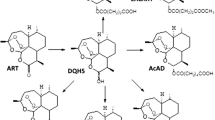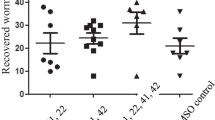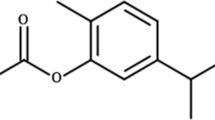Abstract
Artemether is an artemisinin derivative that is used as an antimalarial drug, especially in situations where chloroquine resistance is suspected. This compound has proved to be a good prophylactic agent against schistosomiasis japonica in China. In the present study, the therapeutic efficacies of different artemether-dosing protocols were evaluated in experimentally infected mice harbouring adult Schistosoma mansoni (Egyptian strain). Mice were treated on day 46 onwards with three dosing protocols (400 mg/kg/day for 2 days; 200 mg/kg/day for 4 days; 100 mg/kg/day for 6 days) after being infected. A number of parasitological and histopathological criteria were employed in the assessment of drug efficacies compared to infected untreated control 2 weeks post-treatment. The results of the present study suggest that artemether is efficacious against the Egyptian strain of S. mansoni with total worm reductions ranging from 40.7% to 59.7% and female worm reductions ranging from 69.3% to >90%. In addition, artemether induced significant reductions, ranging from 75.2% to 82.6%, in the liver tissue egg loads as well as significant reductions, ranging from 68.8% to 78.9% in the intestinal wall egg loads. It also induced significant alterations in the oogram pattern in the intestinal mucosa of infected mice with cessation of oviposition and increased rates of dead eggs. Antipathologic activities were also evident in the amelioration of granulomas in the liver with increased ratios of healed to active ones. In conclusion, artemether could be a promising agent in the control of schistosomiasis mansoni due to its schistosomicidal effects on female worms and to its ovicidal power as well as its potentiality in the improvement of hepatic lesions.


Similar content being viewed by others
References
Abdel Aziz SS, el-Badawy NM (2000) Experimental trials of an artemisinin derivative in treatment of Schistosoma mansoni infected mice. J Egypt Soc Parasitol 30:295–303
Abdul-Ghani R, Loutfy N, el-Sahn A, Hassan A (2009a) Current chemotherapy arsenal for schistosomiasis mansoni: alternatives and challenges. Parasitol Res 104:955–965
Abdul-Ghani R, Loutfy N, Hassan A (2009b) Myrrh and trematodoses in Egypt: an overview of safety, efficacy and effectiveness profiles. Parasitol Int 58:210–214
Andrade ZA, Grimaud JA (1986) Evolution of the schistosomal hepatic lesions in mice after curative chemotherapy. Am J Pathol 124:59–65
Andrade ZA, Grimaud JA (1988) Morphology of chronic collagen resorption. A study on the late stages of schistosomal granuloma involution. Am J Pathol 132:389–399
Bergquist R, Utzinger J, Chollet J, Xiao SH, Weiss NA, Tanner M (2004) Triggering of high-level resistance against Schistosoma mansoni reinfection by artemether in the mouse model. Am J Trop Med Hyg 71:774–777
Botros SS, Bennett JL (2007) Praziquantel resistance. Expert Opin Drug Discov 2(Suppl 1):S35–S40
Botros SS, Mahmoud MR, Moussa MM, Nosseir MM (2007) Immunohistopathological and biochemical changes in Schistosoma mansoni-infected mice treated with artemether. J Infect 55:470–477
Caffrey CR (2007) Chemotherapy of schistosomiasis: present and future. Curr Opin Chem Biol 11:433–439
Chaiworaporn R, Maneerat Y, Rojekittikhun W, Ramasoota P, Janecharut T, Matsuda H et al (2005) Comparative studies on the pathological findings and mortality in Schistosoma mansoni infected mice after treatment with artesunate and the current antischistosomal drugs. Southeast Asian J Trop Med Public Health 36:1118–1124
Cheever AW (1968) Conditions affecting the accuracy of potassium hydroxide digestion techniques for counting Schistosoma mansoni eggs in tissues. Bull World Health Organ 39:328–331
Chitsulo L, Engels D, Montresor A, Savioli L (2000) The global status of schistosomiasis and its control. Acta Trop 77:41–51
El-Lakkany NM, Seif el-Din SH, Badawy AA, Ebeid FA (2004) Effect of artemether alone and in combination with grapefruit juice on hepatic drug metabolising enzymes and biochemical aspects in experimental Schistosoma mansoni. Int J Parasitol 34:1405–1412
Fallon PG, Tao LF, Ismail MM, Bennett JL (1996) Schistosome resistance to praziquantel: Fact or artifact? Parasitol Today 12:316–320
Fenwick A, Webster JP (2006) Schistosomiasis: challenges for control, treatment and drug resistance. Curr Opin Infect Dis 19:577–582
Golenser J, Waknine JH, Krugliak M, Hunt NH, Grau GE (2006) Current perspectives on the mechanism of action of artemisinins. Int J Parasitol 36:1427–1441
Gryseels B, Mbaye A, de Vals SJ, Stelma FF, Guissé F, van Leishout L et al (2001) Are poor responses to praziquantel for the treatment of Schistosoma mansoni infections in Senegal due to resistance? An overview of the evidence. Trop Med Int Health 6:864–873
Gryseels B, Polman K, Clerinx J, Kestens L (2006) Human schistosomiasis. Lancet 368:1106–1118
Ismail M, Metwally A, Farghaly A, Bruce J, Tao LF, Bennett JL (1996) Characterization of isolates of Schistosoma mansoni from Egyptian villagers that tolerate high doses of praziquantel. Am J Trop Med Hyg 55:214–218
Ismail M, Botros S, Metwally A, William S, Farghally A, Tao LF et al (1999) Resistance to praziquantel: direct evidence from Schistosoma mansoni isolated from Egyptian villagers. Am J Trop Med Hyg 60:932–935
Kayser O, Kiderlen AF, Croft SL (2003) Natural products as antiparasitic drugs. Parasitol Res 90(Suppl 2):S55–S62
Le WJ, You JQ, Yang YQ, Mei JY, Guo HF, Yang HZ et al (1982) Studies on the efficacy of artemether in experimental schistosomiasis. Acta Pharmacol Sin 17:187–193
Mahmoud MR, Botros SS (2005) Artemether as adjuvant therapy to praziquantel in murine Egyptian schistosomiasis mansoni. J Parasitol 91:175–178
Mehlhorn H (2008) Encyclopedia of parasitology, 3rd edn. Springer, Berlin, p 1542
Mehlhorn H, Frenkel JK, Andrews P, Thomas H (1982) Light and electron microscopic studies on Schistosoma mansoni granulomas of mouse livers following treatment with praziquantel. Tropenmed Parasitol 33:229–239
Nare B, Smith JM, Prichard RK (1990) Schistosoma mansoni: levels of antioxidants and resistance to oxidants increase during development. Exp Parasitol 70:389–397
Pellegrino J, Oliveira CA, Faria J, Cunah AS (1962) New approach to the screening of drugs in experimental schistosomiasis mansoni in mice. Am J Trop Med Hyg 11:201–215
Pellegrino J, Lima-Costa FF, Carlos ML, Mello RT (1977) Experimental chemotherapy of schistosomiasis mansoni. Parasitol Res 52:151–168
Pica-Mattoccia L, Cioli D, Archer S (1989) Binding of oxamniquine to the DNA of schistosomes. Trans R Soc Trop Med Hyg 83:373–376
Picquet M, Vercruvsse J, Shaw DJ, Diop M, Ly A (1998) Efficacy of praziquantel against Schistosoma mansoni in northern Senegal. Trans R Soc Trop Med Hyg 92:90–93
Smithers SR, Terry RJ (1965) The infection of laboratory hosts with cercariae of Schistosoma mansoni and the recovery of adult worms. Parasitology 55:695–700
Steinmann P, Keiser J, Bos R, Tanner M, Utzinger J (2006) Schistosomiasis and water resources development: systematic review, meta-analysis and estimates of people at risk. Lancet Infect Dis 6:411–425
Utzinger J, N’Goran EK, N’Dri A, Lengeler C, Xiao SH, Tanner M (2000) Oral artemether for prevention of Schistosoma mansoni infection: randomised controlled trial. Lancet 355:1320–1325
Utzinger J, Xiao SH, N’Goran EK, Bergquist R, Tanner M (2001) The potential of artemether for the control of schistosomiasis. Int J Parasitol 31:1549–1562
Utzinger J, Chollet J, Tu Z, Xiao SH, Tanner M (2002) Comparative study of the effects of artemether and artesunate on juvenile and adult Schistosoma mansoni in experimentally infected mice. Trans R Soc Trop Med Hyg 96:318–323
Utzinger J, Keiser J, Xiao SH, Tanner M, Singer BH (2003) Combination chemotherapy of schistosomiasis in laboratory studies and clinical trials. Antimicrob Agents Chemother 47:1487–1495
White NJ (1994) Artemisinin: current status. Trans R Soc Trop Med Hyg 88(Suppl 1):S3–S4
WHO Expert Committee (2002) Prevention and control of schistosomiasis and soil-transmitted helminthiasis. World Health Organ Tech Rep Ser 912:1–57
Wu LJ, Yang HZ, Yang YQ (1983) Histological and histochemical changes of Schistosoma japonicum and host liver caused by artemether. Acta Pharm Sinica 18:7–14
Xiao SH, Catto BA (1989) In vitro and in vivo studies of the effect of artemether on Schistosoma mansoni. Antimicrob Agents Chemother 33:1557–1562
Xiao SH, Chollet J, Weiss NA, Bergquist RN, Tanner M (2000a) Preventive effect of artemether in experimental animals infected with Schistosoma mansoni. Parasitol Int 49:19–24
Xiao SH, Shen B, Chollet J, Utzinger J, Tanner M (2000b) Tegumental changes in adult Schistosoma mansoni harbored in mice treated with artemether. J Parasitol 86:1125–1132
Xiao SH, Chollet J, Utzinger J, Matile H, Mei J, Tanner M (2001) Artemether administered together with haemin damages schistosomes in vitro. Trans R Soc Trop Med Hyg 95:67–71
Xiao SH, Shen B, Utzinger J, Chollet J, Tanner M (2002) Ultrastructural alterations in adult Schistosoma mansoni caused by artemether. Mem Inst Oswaldo Cruz 97:717–724
Xiao SH, Guo J, Chollet J, Wu JT, Tanner M, Utzinger J (2004) Effect of artemether on Schistosoma mansoni: dose-efficacy relationship, and changes in worm morphology and histopathology. Chin J Parasitol Parasit Dis 22:148–153
Xiao SH, Utzinger J, Chollet J, Tanner M (2006) Effect of artemether administered alone or in combination with praziquantel to mice infected with Plasmodium berghei or Schistosoma mansoni or both. Int J Parasitol 36:957–964
Acknowledgements
The authors would like to express their gratitude to those who helped us in the Schistosome Biological Supply Centre, TBRI (Cairo, Egypt). Our outmost gratitude is to Prof. Shu-Hua Xiao, China, for the online help regarding artemether suspension preparation. We greatly acknowledge the suggestions and comments provided by Prof. Dr. Amel el Sahn, High Institute of Public Health (HIPH), Alexandria University, and Prof. Dr. Nibal Hammouda, Faculty of Medicine, Alexandria University. We also thank Mr. Hany Hussein from the Biostatistics Department, HIPH, Alexandria University, for assistance in the statistical analysis of data.
Author information
Authors and Affiliations
Corresponding author
Rights and permissions
About this article
Cite this article
Abdul-Ghani, R., Loutfy, N., Sheta, M. et al. Artemether shows promising female schistosomicidal and ovicidal effects on the Egyptian strain of Schistosoma mansoni after maturity of infection. Parasitol Res 108, 1199–1205 (2011). https://doi.org/10.1007/s00436-010-2163-9
Received:
Accepted:
Published:
Issue Date:
DOI: https://doi.org/10.1007/s00436-010-2163-9




